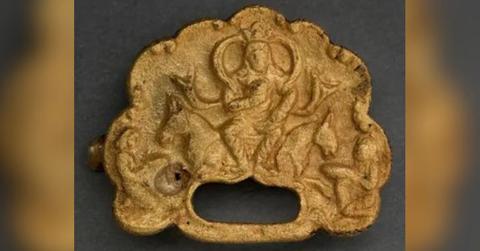Ancient Glam Unearthed: 1,500-Year-Old Asian Tomb Reveals Gold Belt Buckles Believed to Be Used by Royalty

Archaeologists in Kazakhstan discovered two ancient belt buckles depicting the first-ever representations of an early civilization's royalty.
Jan. 28 2024, Published 9:09 a.m. ET
In the heart of central Asia, archaeologists have recently uncovered a collection of centuries-old gold plaques bearing the earliest-known depictions of royalty from an ancient civilization, according to sources.
These dazzling artifacts, believed to have served as belt buckles, were discovered at the Eleke Sazy site — a 1,500-year-old tomb situated near the remote eastern borders of Kazakhstan, sharing proximity with China, Mongolia and Russian Siberia.
The Kazakhstan Institute of Archaeology conducted the excavation, revealing two gold ornaments approximately 1.5 inches in diameter. Both pieces feature elaborate designs portraying a ruler seated on a throne, surrounded by horses and servants offering food.
These plaques represent the first visual representations of a "Göktürk Khagan," as reported by Turkish news outlet TRT Haber.
The Göktürk Khagan, also known as "khagan" or "kagan," held a supreme role as the ruler of a nomadic confederation of Turkic-speaking people known as the Göktürks, who inhabited the region for around three centuries.
The presence of holes in these artifacts suggests they were used as belt buckles. Zainolla Samashev, the lead archaeologist, emphasized that wearing a golden belt symbolized dominance in the ancient Turkish states.
Samashev explained that the artistic composition depicts the kagan seated cross-legged in the traditional Turkish style, adorned with a crown resembling a three-cornered halo. The throne, bridesmaids and surrounding flowers — reminiscent of those in Buddhist art, particularly the lotus flower — compose the intricate scenes.
According to Samashev, the significance lies in the newfound insights into Göktürk enthronement ceremonies, TRT Haber reported.
Never miss a story — sign up for the Front Page Detectives newsletter. Be on the scene the moment news breaks.
The artifacts were discovered in the central burial chamber of the tomb, where a nobleman had undergone cremation. Live Science reported that one of the buckles had suffered damage from the fire.
The extensive complex, measuring 300 feet in length and 165 feet in width, consists of stone and dirt structures, with two main sections enclosed by courtyard walls.
In an adjacent “labyrinth” constructed for visiting pilgrims, archaeologists unearthed a damaged stone sculpture believed to represent the tomb's occupant. This headless sculpture, accompanied by numerous other artifacts like weapons, horse equipment and items crafted from silver, iron, bronze and crystal, adds further layers to our understanding of this ancient civilization's customs and rituals.
Become a Front Page Detective
Sign up to receive breaking
Front Page Detectives
news and exclusive investigations.
